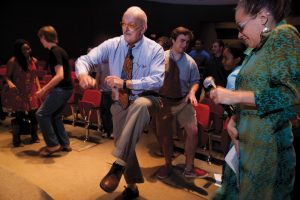Alyssa Falco
The African Diaspora is something that is practiced very actively in Nigeria and other parts of Africa. Throughout the video is was always stated how the people were forced away from their homeland and now they chose to come back. This idea of them coming back gives them the power back as to what they may have lost by leaving. However, I believe that if you wish to practice something you do it at you own will. The idea of there being one God, and depending on what that God may be, whether you are Catholic and worship God and Jesus or you worship Oshun, it is a person’s choice. In the movie the priest said “we left Africa but Africa didn’t leave us.” I find this very powerful as to the fact that all these people are doing exactly what they would have done if they had stayed in Africa. They were given the choice and they chose to follow or continue with their religion. This festival allows people to be apart of this religion and to see for themselves what it means to the people who practice it. The festival is a huge part of explaining what the African Diaspora is and what it can mean. Just by watching this video and seeing how people worship Oshun you can tell that they put their faith in her. The king even comes and worships with them. In the reading “Intro to Philosophy of History” by Hegel, he says “Religion begins with the consciousness that there is a being higher than man.” (92). No matter how cruel Hegel may have been, this quote makes sense and is very well seen that that is exactly what takes place in Africa. These people to believe there is a higher being than man and Hegel himself is saying that that itself is a religion. Towards the end of the video the question kept arising, “how can a church be next to a temple and coexist with one another?” How can they not is my response. Look at America, where I grew up there was 3 different kinds of Christian and Catholic churches just in my town. In the next town over there was a jewish center across the street from a Christian church. This happens all the time in America. Yes, some religions may be more popular than others, however no brawls broke out in my town about what religion you prefer. The people who worship Oshun have numbers, not even that, they have people who support their religion that don’t even practice it. It is possible for them to be a community and live by what they believe. Along with every religion comes the idea of wanting to make yours bigger because you may be so passionate about your religion you want everybody to be apart of it, so you ask people to join and ask them to give it a try. But it shouldn’t matter who comes knocking at your door, you can chose to believe in what you wish and these people are doing just that. Their festival is known worldwide. People are aware of them, people respect them. Not only that but they believe in themselves, they have their higher being and they will worship their being until they can’t any longer. That’s all a religion needs, followers.
